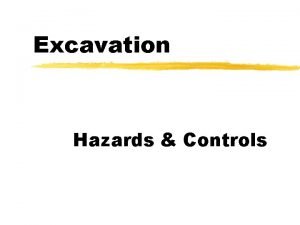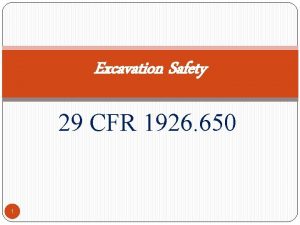How to install pavers Step 1 Excavation Using















- Slides: 15

How to install pavers.

Step 1. Excavation • Using spray paint and stakes, lay out rough outline.

Step 1. (cont’d) • Determine the finished grade. • Calculate the excavation depth by adding: – Paver thickness – Sand or screenings layer (1”) – Base material layer (4”-6”)

Step 1. (cont’d) • Excavate a minimum of 6” beyond each side of the patio • Create a 2% minimum slope away from structures for proper drainage. • Be careful not to disturb soil below excavation depth. This can cause unwanted settling.

Step 2. Stake out the area • Lay out the edges of the walkway with stakes and string set at finished grade.

Step 3. Prepare the base • • • Add base material in 2 -3” layers. Compact no more than 4” at one time. Compact thoroughly after each layer. Add moisture sparingly if necessary. Base should extend 6” beyond finished dimensions.

Step 3. (cont’d) • Use a plate compactor to flatten the base. • Check height and maintain the proper slope. • If necessary add more base material and compact again.

Step 4. Screeding • Place two lengths of 1” pipe parallel to each other on the base to be used as leveling guides. • Shovel screenings between the pipes.

Step 4. (cont’d) • Using a 2 x 4, screed the H. P. B. or sand back and forth to make it smooth. • Remove pipes and fill in voids with H. P. B. or sand using a trowel.

Step 5. Lay pavers • Start in a corner and work outward. • Hold each paver against neighboring pavers and slide it straight down.

Step 5. (cont’d) • Avoid sliding pavers across the sand. • Lay out according to desired pattern. • If some pavers need cutting, snap a chalkline over the top of the pavers.

Step 5. (cont’d) • Use a guillotine or hammer and chisel for simple cuts • For angled and cleaner cuts, use a wet saw. • Always wear appropriate P. P. E. when cutting pavers.

Step 6. Install edging • A variety of materials can be used for edging. • The most commonly used edging is L-shaped plastic with notches to allow for curves. It is secured by 10” spikes.

Step 7. Compact pavers • When all pavers have been laid, make one pass over them with a plate compactor.

Step 7. (cont’d) • Spread sand over the surface and sweep into the cracks. • Sweep clean and then make a final pass with the plate compactor. • Sweep more sand into the cracks as needed.
 Step 1 step 2 step 3 step 4
Step 1 step 2 step 3 step 4 What is benching in excavation
What is benching in excavation Osha trench benching
Osha trench benching Trenching and excavation safety meeting
Trenching and excavation safety meeting Bassin obstétrical définition
Bassin obstétrical définition Diametre sacro cotyloidien
Diametre sacro cotyloidien Excavation cmr
Excavation cmr Excavation hazards and controls
Excavation hazards and controls Engage in excavation
Engage in excavation Peck
Peck Hard barrication standards
Hard barrication standards Pelvimetrie externe
Pelvimetrie externe Dr dawood
Dr dawood Foundation engineering services
Foundation engineering services Excavation technology
Excavation technology Lspcc excavation
Lspcc excavation




























